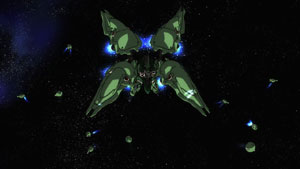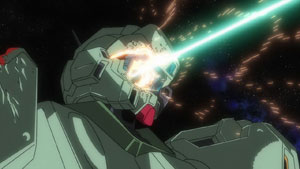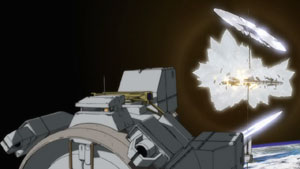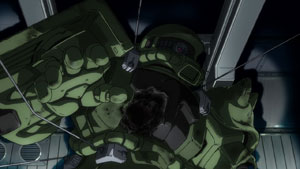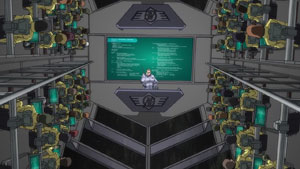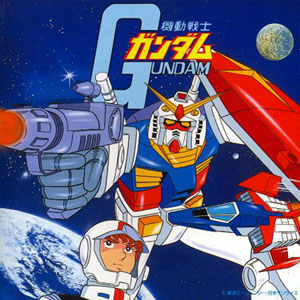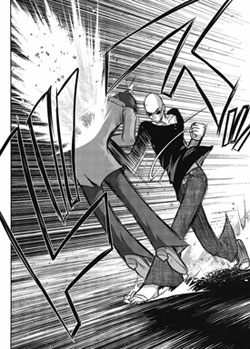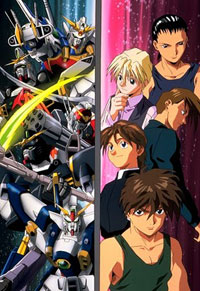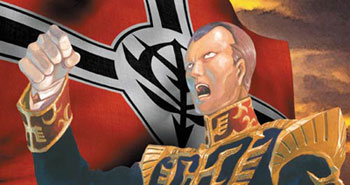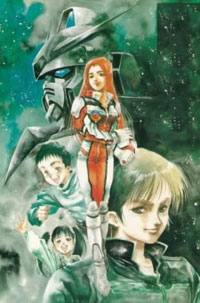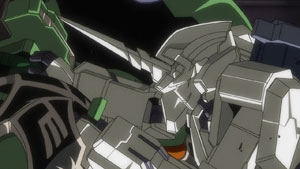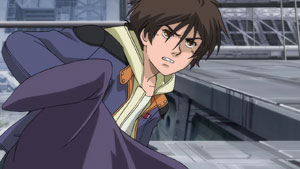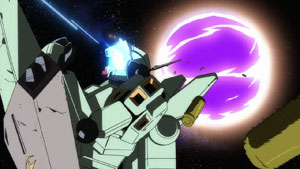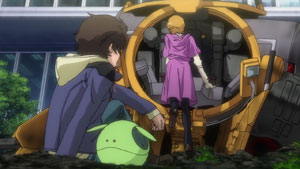 Logo handmade by Bannister
Column by Scott Green
Logo handmade by Bannister
Column by Scott Green
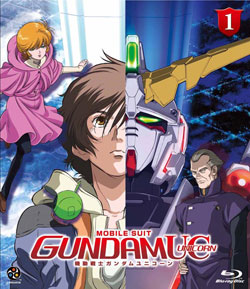
Anime Spotlight: Mobile Suit Gundam Unicorn Vol. 1 Released by Bandai Visual
In an early Gundam Unicorn space battle, a green humanoid weapon system, "mobile suit" in Gundam parlance, employs a flood of twenty something remote controlled, independently propelled beam cannons known as funnels to slice a Gundam Mass-production type (GM) to hell. Head mounted vulcan cannons blast the attacker before Macross Itano Circus like vortex of missiles storm its way. This hardly slows the green, beetle-ish Kshatriya when it responds to the counter attack with its remote pods melting through the heads of opponents, cutting through others with its giant robot sized light saber (beam saber around these parts). As the mecha collide, a neat air bag system deploys then retracts, preventing Blue Gender style pilot death by head trauma. A conceptual high spot hits quickly when Minovsky particles, the rarely evoked justification for why the seemingly impractical mobile suit based warfare of Gundam is hard sci-fi-ish, does get evoked. (The particles function as a power source that also serve to interfere with electronic sensor systems.)The Gundam franchise's first hero was emotionally handicapped reluctant pilot Amuro Ray. I'd argue that it's second, Kamille Bidan, was autistic. No exaggeration. Gundam Unicorn's Banagher Links (names here are extravagantly noticeable - there's a character who goes by "Full Frontal"), is a NewType, the presumed next step in human evolution, with a mind tuned for life in space. And, like most other NewTypes he's socially awkward. Yet, this is a guy who locks eyes with opponents, and while they're getting too chatty, keys in an attack (of sorts) routine on his Haro (green orb mascot robot, invented by Amuro in the peace time before the original Gundam). In the ensuing low gravity foot chase, the young hero tries a hand plant spin kick on a pursuing woman and when she responds in kind, he grabs her by the overcoat and chucks her. He's no hot blooded Koji Kabuto of Mazinger fame, or even Shiro Amada, the steely nerved commander of the 08th MS Team who took out an enemy mobile suit while on foot, but he is apparently a Gundam pilot whose whininess has been mitigated. Gundam's trademark abstract pontification about the nature of conflict and humanity's destination in space does make an appearance, but for once, the reaction of the veteran captain listening to the speech mirrors that of the audience. He rests his chin on his palm and looks bored and a bit irked. While by no means without intelligence, there are interesting bit such as the movement to relocate great works of art from Earth to space, Gundam Unicorn is not thought provoking sci-fi. It doesn't introduce that much new to a giant robot war franchise that's 30 years old. Instead, it's brilliantly sensational, such that whether you follow anime devoutly or wait around to cherry pick, Unicorn is a tremendously appealing production. As Banagher leaps onto the touch point where flint meets steel in the ignition of a war, Unicorn sizzles with "Wow!" factor. I've literally seen hundreds of Gundam episodes. I can say Unicorn isn't unveiling many new tricks. It's exercising concepts invented (or borrowed) in previous Gundam. And yet, as soon as a robotic arm undocks that green mobile suit into space, the cockpit turns and the pilot adopts a determined look, Unicorn begins shredding away familiarity. Watching the force as pilots push their machines, the bevy of gear light up with scoped trajectories and seeing the lasers start... this is grade A tech in cinematic action. With House of Five Leaves and Tatami Galaxy being simul-streamed in North America, it would be foolish to hold Unicorn up as an artistic achievement in anime, but still, Unicorns quality is exciting in and of itself. Unicorn is set in the Universal Century time line of the original Gundam. In fact, it opens with the official declaration by which that new Universal calendar replaced our modern one. Hope for a fresh start in a new age is soon shattered by the type of conflict that marks the franchise when a vision-filling ringed colony is ripped apart, casting the assembled dignitaries and press into the vacuum of space. As terrible as this attack is to ponder, the orchestrated destruction of bright, chaotic channels breaking apart the metallic order of the colony looks flashy and the type of spectacle proves well suited to Gundam Unicorns style of animation. Gundam has showcased this sort of violence before, but rarely has the spectacle been such a marvel. Unicorn jumps forward to 17 years after the original Gundam's climactic Battle of A Baoa Qu. 16 year old Banagher Links is attending Anaheim Electronics' (a civilian arms developer that sold to both sides in previous conflicts) industrial college. In addition to low gravity classroom, here the students are seated on surfaces perpendicular to the teachers, a psycho frame (a mobile suit with incorporated NewType attuned nano-machines) is secretly being tested. Londo Bell (the peace keeper special forces in which the survivors of the original Mobile Suit Gundam eventually serve) get deployed. Multiple Zeta Gundams, the transforming mecha employed by Kamille Bidan in the like named anime), are fielded. A Pegasus class warship (set for the original Gundam) makes an appearance. Unicorn is Gundam porn. Mobile Suit Gundam MS IGLOO was a set of CG episodes focused on the development of experimental military technology within the Gundam's One Year War. It was so directed at hard core fans that it was originally exclusive to the Bandai Museum. Yet, compared to what Unicorn fields, IGLOO was merely the swim suit issue. While feeding Gundamites a constant stream of provocative references, Unicorn smartly follows the franchise's direction of opening itself up to audiences beyond its equivalent of trekkies. Like recent relaunches, Gundam SEED and Gundam 00, its war machines are sleek; colored or at least highlighted brightly. And, it tinkers with the Gundam formula. There's still an opening assault on an installation. That attacks still thrusts a teenage male into the role of piloting an advanced Gundam model. But, it also works Joseph Campbell mythic universality into the situation. Elements of this seen in prior Gundam principals are emphasized here. The heroes are unmistakably a boy outsider with a secret, significant past, entrusted with a great weapon and a mysterious princess in disguise on a mission. It's not galaxies away from Star Wars. If you know what Londo Bell is and recognize a Pegasus, Unicorn is fully prepared to capitalize on the attachment . If you don't, "A Baoa Qu" might as well be "Clone Wars." That there is a rich context is great, but for the story of Banagher Links, knowing the specifics isn't a requirement. Universality, along with funnels and twitchy no holds barred mecha dogfights is very captivating combination. Anime fandom has a mania for categorization. In that vein, when it comes to mecha, there is a distinction between super robots and real robots. Go Nagai introduced the first piloted mecha anime/manga with 1972's Mazinger Z (broadcast on American TV as Tranzor Z). This was a "super robot," a brightly colored god-machine that responded to shouted commands, whose powers were as limited or limitless as a given adventure dictated. The tradition was that, on a weekly episodic basis, the young hero would use this armor to defeat some minion of an evil overlord. In contrast, "real robots" were weapons of war rather than power totems. In principle, they were boxy, drab, and mass produced. Reality encroached on their ability. Their power source and weapons had defined limitations. Protagonists would use these weapons in war stories that aimed to reflect the realities of conflict. Airing on the Nagoya Broadcasting Network in 1979, Mobile Suit Gundam was the beachhead for real robot shows. The casus belli for the war for this, and most Gundam series, revolved around the independence of Earth orbiting colonies known as Sides. Politics and morality of conflict in Gundam is intentionally muddied. While the sentiment that humanity's future lies in the space is expressed, its protagonists initially and generally fight on the side of Earth against the rebellious colonies. In the '79 series, the colonies' Zeon faction was lead by villainous types; the Zabi family, who subverted idealistic visions for the "Spacenoids" in favor of dynamistic ambition, ultimately controlled by a man who openly hails Hitler as the model for his action. At the same time, the Earth Federation that the protagonists serve is demonstrated to be unjustified, incompetent, misguided, underhanded or otherwise condemnable in its own right. The Gundam perspective looks to principles as its leads contend with threats rather than even identifying a side with relative superiority. Before the events of Mobile Suit Gundam, the One Year War between Earth and the Sides saw billions in the colonies killed by poison gas attack, nuclear weapons fired, the destruction of three Sides, and another colony dropped on Earth such that a 300 mile crater was created and half the planet's population was killed due to the effects of catastrophic climate change. These actions resulted in the Antarctic Treaty, banning use of nuclear, chemical and biological weapons, as well as dropping asteroids and colonies. Eight months into a stalemate, a Zeon squad infiltrated Side 7, or, specifically, its secret Earth Federation development facility. In the chaos, Amuro Ray, a brilliant, unhappy adolescent from a troubled family finds himself piloting the Federation's prototype RX-78 Gundam mobile suit, then he, and a collection of other civilian refugees become the ad hoc crew for the White Base under officer candidate Bright Noa. Gundam was developed by Yoshiyuki Tomino. Tomino has been in TV anime almost since its beginning, with work under Osamu Tezuka on the first Japanese produced animated TV series, Astro Boy (1963). Not long after directing Tezuka manga adaptation Triton of the Sea (1972), Tomino began working on mecha anime with series like Brave Reideen (1975, part of Shogun Warriors), Super Electromagnetic Machine Voltes V (1977), Invincible Super Man Zambot 3 (1977), and Invincible Steel Man Daitarn 3 (1978). There's an image of Osamu Tezuka as an artist in a beret. The Tezuka one thinks of is this creator, hunched over the drawing board. In contrast, the vision of Tomino is that of a maniac. In fact, there's a currently running manga called Gundam Sousei that goofs on the notion of bald, force of nature Tomino developing Gundam. The first chapter opens with the comically exaggerated Tomino deck Amuro Ray voice actor Furuya Tooru to get him into the spirit to for a famous scene in which Bright slaps the petulant Amuro. Among fans, Amino has earned the moniker "Kill 'em All" (Minagoroshi no Tomino) for his habit of running scorched earth campaigns on his cast. At the conclusion of his mission, titular Atlantean Triton ultimately discovers that he's been enacting an unjust genocidal campaign. As noted in Simon Richmond's Rough Guide to Anime, the concept of Zambot 3 involves the pilots becoming unwitting suicide bombers. A look at the body count of Tomino anime can be read here. Even with about 20 notable character deaths, Tomino's bloody vision was curbed a bit for the Gundam anime. Heroes manage a more favorable survival rate than his novel. Still, Gundam is a notable unsentimental anime. The cast who make it through literally cling on to the end. A classic, climactic Gundam tableau is the titular mech, minus its head an and arm firing ,a drastic final shot. Survival is a desperate endeavor in Tomino anime, and Gundam in particular. Mobile Suit Gundam was not entirely well received when it first ran on Japanese TV. Due to trouble with sponsors, the run was cut from 52 episodes to 43. Ironically, considering what an industry Gundam plastic models would become, there was initially trouble figuring out how to merchandise the property. Gundam is often compared to Star Trek for a number of reasons. Because it's a sci-fi franchise that has inspired interest for decades. Because its fans dress up in the uniforms of its characters. And because it was revived due of the attention it commanded rerunning on television. After three movies retelling the story of the original series, Gundam would return to the same chain of events, and to some extend the same characters (Bright is present from early on; Amuro has a small role, but his adversary, Char has a larger one) in its second series, 1985's Zeta Gundam - in which a fascist regime supplants the Earth Federation following another colony drop by the remnants of Zeon. And, the Zeon wars are the backdrop again for 86's series Mobile Suit Gundam ZZ. These stories, and Amuro's in particular, were brought to a final climax of sorts with the 1988 movie Mobile Suit Gundam: Char's Counterattack. As seen by IGLOO and Unicorn, the Universal Century events would continue to be developed with side stories and further future-set follow-ups, and, it would remain the domain of Gundam's most hard core devotees. Starting in 1994, alternate universe Gundam series started being produced to bring new viewers into the fold. These would take the fundamental of Gundam's conflict between Earth and its orbiting colonies, as well as the young pilot, but depart more from the original's implicit real robot manifesto. 1994's Mobile Fighting Legend G Gundam looked to shonen martial arts tournaments for inspiration, with extravagantly colorful national Gundam's fighting it out (there are some notorious examples, Mexico's serape and sombrero clad Tequila Gundam, the windmill shaped Nether Gundam, Sweden's Sailormoon-esqie Nobel Gundam). 1995's Gundam Wing looked to broaden the audience to female viewers with Gundam Wing, featuring 5 angsty handsome young men, piloting nearly invisible, symbolism laden suits. 1996's After War Gundam X went back towards, dark, male oriented territory with the story of a Gundam war set on a post-apocalyptic earth. Tomino came back for 1999's Turn A Gundam, bringing futurist Syd Mead along with him for what was kindof its own beast, among Gundam and among anime in general, a story in which nations with World War I level technology unearth mobile suits and use them in a war against a human colony from the moon. 2002's Mobile Suit Gundam SEED and it's follow-up SEED Destiny were remakes or at least inspired by the structures of the original Gundam and Zeta Gundam, but with the lessons learned from Wing, to color the mecha brightly and to include a large teen cast, amongst which drama could be enable. Then, in 2007, came Mobile Suit Gundam 00, the first Gundam set in our own timeline, borrowing more directly from current concerns such as energy and religious conflicts. Because I've been writing about anime for over a decade, I've watched most of the Gundam works released in North America. That said, I've never finished a long Gundam without it feeling like an accomplishment (my watch list includes 43 episode Mobile Suit Gundam, 50 episode Zeta Gundam, 49 episode Mobile Fighter G Gundam, 49 episode Mobile Suit Gundam Wing, 50 episode Mobile Suit Gundam SEED, 50 episode Mobile Suit Gundam SEED Destiny - this list of the "long" Gundam works doesn't include the various OVAs and movies). I haven't seen all of Gundam 00, the SD Gundam, or all of the compilation movies. I find Gundam prone to a litany of problems, many of which arose organically in the original. As revolutionary as it was for the genre, viewing it fresh now, it comes off like a toy commercial with some transcendent ambition's bolted on. This became Gundam's uncorrected congenital defect. The conflict between Tomino's vision for Gundam and the need to produce toys is a key suspect for why the original series doesn't coalesce. Certain threads are seen through from beginning to end, but there is so much diffused energy in Gundam that it takes on a propensity to move rather than develop. Specific workings of the science fiction or political concepts, material that would interest older audiences, is particularly apt to get booted to ancillary material rather than appearing in the series itself. For example, while some grand motions do receive screen time, granular details on the dynastic ambitions of the Zabi in the original Gundam and the fascist workings of the Titans in Zeta seem to get short shrift. Whether it was Gundam Wing or Gundam SEED, the secret to scripting a long form Gundam series has proven illusive over the decades. Major battles and campaigns in the wars, legendary antagonists, significant concepts, they all sort of stream past the windows as the unhappy crew of the White Base go from space to Earth, cross the global war, and back into space. As the series moved from one critical phase to the next, I was always constantly curious as to what would happen if it stopped to watch Amuro deal with his mother or witness the full scope of a battle take its course. Later Gundam hectically shift status quo, but at least the venues generally look interesting. In the original, it would have be nice if it slowed down and worked through a situation before moving on, but at the same time, most of the places it visits are so drab, moving on doesn't seem like a terrible idea. Rarely has Gundam figured out a way in which it could utilize its endemic contradictions. Characters ceaselessly orate against war. Yet, if things aren't actively blowing up in bright pops, Gundam is marking time to the next showcase of violence. Mobile suit against mobile suit, mobile suit against hulking, exotic mobile armor, fleet against fleet, super weapon on base or population center, the appeal of Gundam has always been its martial spectacles. And, even before the move to make them more eye catching and less super robot utilitarian, Gundam rested on the visual attraction of its mobile suits. Starting with the enemy ace Char in his red painted custom mobile suits, Gundam's antagonists have mixed danger with flair and thereby been attention grabbing. Even before Gundam made its characters young and attractive, famously old Ramba Ral had a nice looking companion and his own slick advanced model suit. The trouble is that there is similarly an aura around Gundam's opposing factions. Anime fandom has recently developed a Hetalia problem, where, inspired by an anime/manga featuring anthropomorphized nation, various iffy national uniforms and flag get employed in cosplay. Gundam fans crossed that line long ago. Recalling Gihren Zabi's fascist speech and "Sieg Zion!" aren't uncommon occurrences among the mecha fanatic at anime conventions. The aesthetic appeal of fascism registers strongly throughout Gundam. In the Gundam, there no love for authoritarianism, but whereas all systems are corrupt, fascism at least has style. My long standing response to questions about what Gundam series to watch has been Gundam 0080: War in a Pocket, the six episode story of a boy from a neutral colony whose immature visions of conflict are shattered when he sees fighting up close. It's well animated... Mitsuo Iso's opening sequence in which in amphibious mobile suit crashes an Arctic base, subduing multiple opponents is a real achievement in motion and choreography. Yet, though this isn't a Tomino work, the intended spirit is powerfully conveyed. A failing of the franchise is that the feeling of senseless tragedy conveyed in this short series is rare for Gundam. Gundam Unicorn adapts a series of 10 light novels (physically small, often genre prose books, written for quick reading; sometimes serialized, as in the case with Unicorn, which ran in Gundam Ace) by Harutoshi Fukui (writer of a number of other military stories, including Bôkoku no îjisu - a terrorist drama concerning a hightech cruiser adapted into the movie Aegis and Shuusen no Lorelei - about a World War II submarine working to stop a third atomic bombing of Japan; as well as army time travel Samurai Commando Mission 1549). Unconventional for anime these days, the series will be adapted into an episode at a time released six part original video animation (OVA). Episode two is expected later this year - an interval far from unheard of an OVA production. The direct to video OVA format has fallen out of favor as a production model for anime since the times in which Gundam revisited the Universal Century timeline with Mobile Suit Gundam 0080: War in the Pocket (1989, commemorating the tenth anniversary of Gundam, written by Royal Space Force: The Wings of Honneamise's Hiroyuki Yamaga, with character design from Macross' Haruhiko Mikimoto and new mecha design from Yutaka Izubuchi), 1991's Mobile Suit Gundam 0083: Stardust Memory (bridging the original Mobile Suit Gundam with Mobile Suit Zeta Gundam, featuring designs from Macross' Shoji Kawamori and Bones co-founder Toshihiro Kawamoto) and 1996's Mobile Suit Gundam: The 08th MS Team (featuring an old by Gundam standards 24 year old lead, and following non-aces in a ground war, an alternate perspective on the One Year War). When anime was taking off in North America, there was a hierarchy of anime production. OVA generally had more production funding per minute than TV series. Movies had more than OVA. And, as anime was booming, fans were seeing plenty of each. There were never many anime movies, apart from annual franchise tie-ins (One Piece, Crayon Shin-Chan, a handful of others), but anime watchers had a back log to work through. On the other hand, the OVA market hadn't quite burned out yet. Unfortunately, the format, which was once experimental territory for testing out ideas or IP proved to be a product of Japan's economic boom years. As the high times faded, tie-ins for diehard fans came to constitute the narrow stream of remaining OVA productions. It's been argued that the future of anime is in producing a few movies rather than the now slimming, but still to the minds of many excessive amount of series airing on Japanese TV. This would not be dissimilar to how kung fu movies evolved... rather than a lot of small productions crowding the market, a few big ones are made. It might sound like too many eggs in one basket, so if anime does go in that direction, bankable institutions like franchises like Gundam and possibly celebrity directors may receive more focus as the subject of promotion from project to project. An OVA series like Gundam Unicorn currently looks like anime's past, but, it may also look like anime future. The OVA format suits Gundam Unicorn well. It's directed by Kazuhiro Furuhashi, who was involved with some military anime, Zipang - about a modern Japan Defense Ship destroyer transported back to the eve of the battle of Midway, but he's more a go to guy for sword based action with Rurouni Kenshin (TV and OVA) and Le Chevalier D'Eon on his resume. Writer Yasuyuki Muto is again a swords guy with credits including Basilisk and Afro Samurai: Resurrection. While they've produced some impressive work, this is not a staff I see and know I'm going to get something stellar. At least not in this context. Here, they have the time and attention afforded by the OVA format - producing rapidly dynamic complexity on screen. And with the parameters of an OVA, the meandering and contradictions that plague longer Gundam are minimized. With the quality animation and the cut to the chase structure, they've managed a riveting first episode for Unicorn. You'll have to wait the better part of a year for episode two, but if it's as good as one, it will be worth it. Now, the caveat... Gundam Unicorn is expensive...Relegating itself to niche expensive. Gundam has had a significant role in the history of anime in general and anime in North America specifically. It's one of the biggest non (young) children's franchises over the decades and one of the most active. Beyond the evidence of celebrity comedians famous for their Gundam impressions and the one-to-one sized statue, look at the February 2009 re-organization of Bandai Visual. Departments included anime, music, film, character goods, high-end and Gundam. When Gundam was brought over to North America, Bandai seemed both excited about the potentially lucrative expansion and protective. Gundam Wing ran on Cartoon Networks evenings and late nights, and its broad audience appeal did in fact attract a broad audience. As the anime boom was picking up steam, its androgynous leads and J-pop music found plenty of welcome viewers. In the wake of that attention, Gundam model kits hit stores from Toys R Us to Wal-Mart. This moderate, early success did not translate into major success and did not persist. Model kits stopped selling and were eventually liquidated at deep discounts. A new Gundam was never embraced to the extent of Gundam Wing. There's a sense that Bandai recognizes that America did not develop its tastes for sci-fi with Astro Boy and Mobile Suit Gundam and therefore is a bit resistant to the franchise. Yet, at least through Gundam 00, the thought was that while the last iteration didn't reach expectations, with the right tweak to the formula, the next reinvention will be as big as Gundam wing, if not bigger. The thinking, supported by the Wing history, has evidently been that Gundam does not need to be limited to a niche audience in North America. And yet, it's been the niche, hardcore that has stuck with the franchise. At the same time, hard core fans have felt abused by it. Contradicting the tastes of those hardcores, the original Gundam TV series has never been released in North America with a Japanese audio. Presumably this is part of the protectiveness regard for the franchise, making sure that the English release didn't impede Japanese DVD sales. Then there was the release of the Zeta Gundam box set, an incident that still gets invoked as a reason for why Gundam faithful have had a sour regard for the franchise's handling in North America. In 2004, Bandai Entertainment put out a box set release of Gundam's well regarded second season. The hard core fans, the target audience for this $200 collection, weren't impressed by the English dub and were even less impress by the use of the same script for that dub and for the subtitle text (usually, two scripts are used, with the English dub getting a more liberal translation). Buyers were told that the series would not be re-released (it was later published in 2 disc sets), but weren't told that opening and closing music had been changed (Zeta Gundam themes were variants on Neil Sedaka music). These hardly qualify as mortal sins against anime. Yet, Gundam's North American audience is largely dedicated fans, and those fans are the type the given to long memories and pickiness. For all its appeal to fans of action sci-fi, and all of Gumdam's global ambitions, Unicorn follows the pattern for a dedicated, niche audience. The 60 minute episode is available as a Blu-ray exclusive to Amazon, where it sells for $49.98 (less if you can hit a discount), as part of a (near) global launch coordinated by Bandai Visual in Japan (rather than Bandai Entertainment in the US). I haven't seen any negative remarks about the production or Blu-ray transfer. What's on the disc itself is certainly excellent. The release format is very Japanese, along the lines of what was seen from Bandai Visual short lived Honneamise label. An argument has been made that this is what anime needs to fund its productions. That American anime fans should follow the behavior of their Japanese counterparts, and buy at this set price. As one person said, you don't ask Hermes to lower prices so more people can buy their products. My argument to that was/is that even in the recession thinned landscape, there is still a glut of entertainment choices out there. Most, even sci-fi fans, will divert themselves with something else. It's a small number of Gundam zealots who will spend $49.98 (or less if Amazon is running discount) on episode 1 of 6. Douglas Adams (of Hitcher's Guide fame) wrote Last Chance to See, about travelling the world to visit endangered animals. In New Zealand, he sought out the critically endangered kakapo,a flightless, nocturnal parrot. With no natural predators and abundant resources, it developed a protracted, inefficient mating practice so as to not overpopulate. When cats were introduced to its island, it began getting eaten more quickly than it could reproduce. As Adams put it, faced with a new challenge, it did what it was evolved to do, mate in a protracted, inefficient process. Anime has evolved to where it is sold to consumers who identified themselves as anime fans. Piracy, competition from other media and over specialization hurt the industry. The new, spectacular sci-fi comes out, and it has the name of a franchise with 30 years of history/baggage attached and a price tag higher than a box set. Is it worth it? In its genre, nothing is likely to touch Gundam Unicorn episode one until Gundam Unicorn episode two comes out. It certainly shames Halo Legends. If you show it to someone with no Gundam knowledge, will they enjoy it? If they have any taste for animated action sci-fi, definitely. Yet, it could be revolutionary, it could transcend all expectations, (as good as it is, it's neither) and I still don't think that there will be many outside the niche of Gundam fans within the niche of anime fans that will buy Unicorn.

